Top Tier CPU Air Coolers Q3 2015: 9-Way Roundup Review
by E. Fylladitakis on July 6, 2015 8:00 AM ESTThe Thermalright Macho Zero
Being one of the oldest and most reputable manufacturers of advanced cooling solutions, Thermalright does not really need much of an introduction in such a review. Ever since 2001, Thermalright is totally focused on designing and producing cooling solutions for PC components, with the mere exception of a heatsink for the XBOX 360. The company greatly surprised us with their submission for this review. With this being a roundup review of top performance coolers, almost anyone would expect to see the Silverarrow or HR-22 (or a Copper TRUE? - Ian). However, Thermalright submitted the Macho Zero - a cooler optimized for passive performance and low airflow environments!
Thermalright supplies the Macho Zero in a very plain black cardboard box, with just a schematic of the cooler printed on it. Inside the box, the cooler is very well protected inside thick polyethylene foam pieces. Note that the Macho Zero is not supplied with a fan. For the means of this review, Thermalright supplied us with a single TY-147A 140 mm fan.
The bundle of the Macho Zero is the most thorough of this review. Thermalright nickel-plated the screws and retention plates necessary for the mounting of the cooler, supplies a tube of quality "Chill Factor III" thermal paste, anti-vibration rubber pads and wire clips for one cooling fan, provides a full size magnetic 150 mm shank Philips PH2 screwdriver and even gloves for the installation of the cooler.
Although the Macho Zero is primarily optimized for semi-passive cooling, meaning that it has been designed to make use of the airflow generated by the fans of the case, it is possible to install any 120 mm or 140 mm fan on it. For the means of this review, the cooler had to be in active configuration, therefore Thermalright supplied us with a TY147A 140 mm fan. The white bladed fan with the rounded frame is a model designed for efficient airflow and low-noise operation. This means that the fan is optimized for low impedance applications, such as to replace case fans. Normally, that would make it mediocre for a very dense cooler, but that is not the case with the Macho Zero. It has a maximum rotational speed of 1300 RPM and an "enhanced hyper-flow bearing", for which we could not find specific information about, but it definitely is a form of fluid sleeve-type mechanism.
The Macho Zero is an imposing, large single tower CPU cooler. Its fins are almost perfectly rectangular, with many openings across their great surface. There are not too many fins though, as the spacing between them is very large in comparison to other coolers. This has been done to optimize this cooler for very low airflow environments and greatly lowers its airflow impedance. For aesthetic purposes, Thermalright painted the top fin black, yet it does not cover the heatpipe endings. There is a fairly large hole near the rear side of the fins, meant for the screwdriver to go through for the mounting of the cooler. Note that for the mounting of this cooler, the front fan (if present) needs to be removed as well.
Typically, the Macho Zero is designed for use without a fan. An optional fan can be used of course, but remember that high airflow / low pressure options are likely to be far more effective than high pressure fans. The provided wire clips are an excellent fit for 140 mm fans with rounded frames, yet their configuration does not allow the adjustment of the fan's height. It would be wise to check the mechanical specifications of the cooler and make sure that the installation of a fan does not restrict the installation of RAM modules in slots that need to be used.
The base of the Macho Zero is of notable importance. The copper base is rectangular and wide to provide full contact with Haswell-E processors, with six 6 mm heatpipes going through it. The heatpipes are split into two groups, with heatpipes 1-3-5 expanding near the rear of the heatsink and heatpipes 2-4-6 near the front. This approach allows the localized generation of a heavy thermal load to be split across the surface of the fins. Everything is nickel plated and the contact surface is treated to a perfect mirror finish.


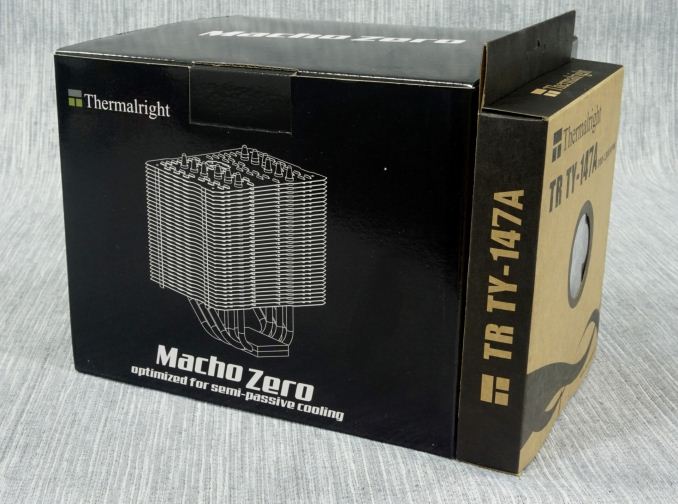
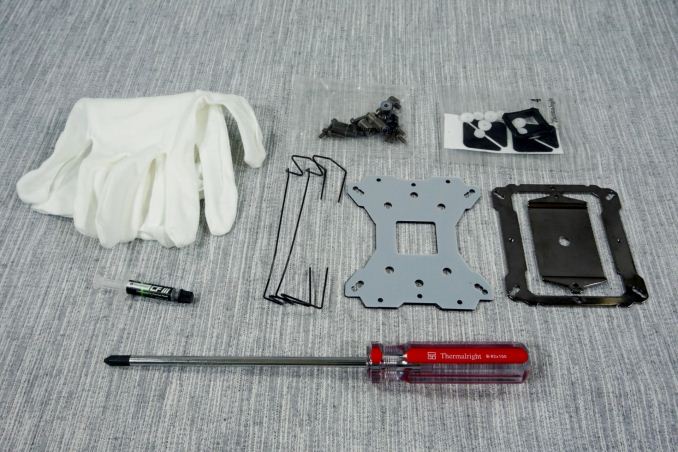
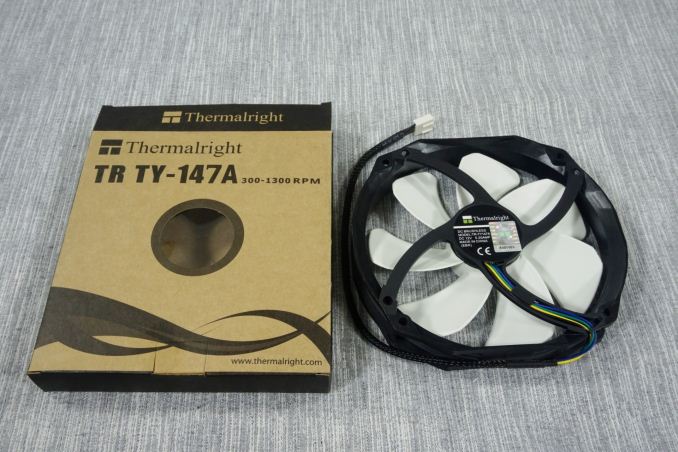
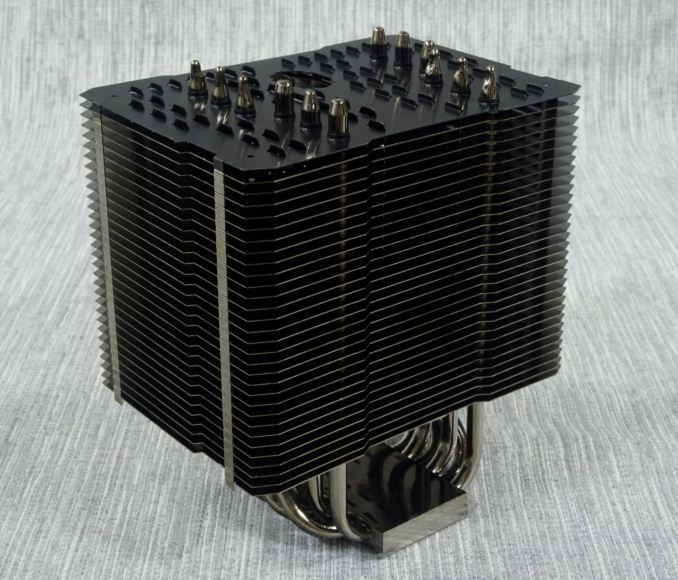
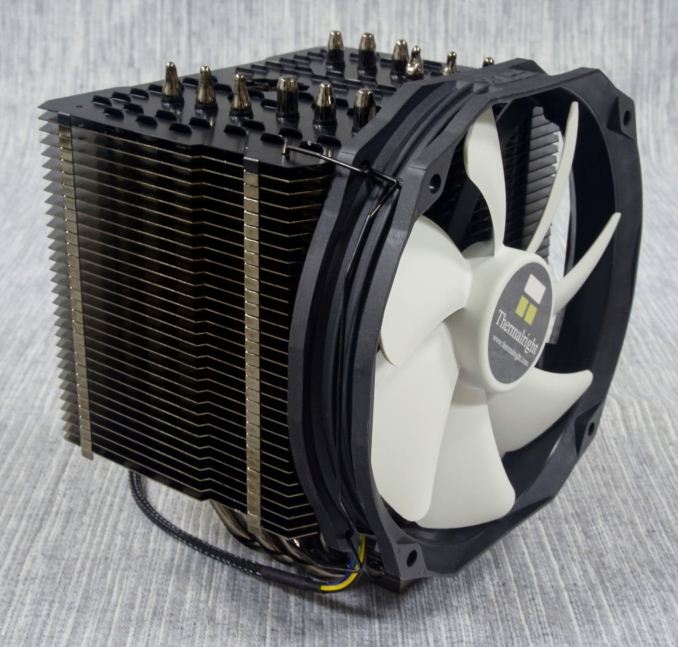
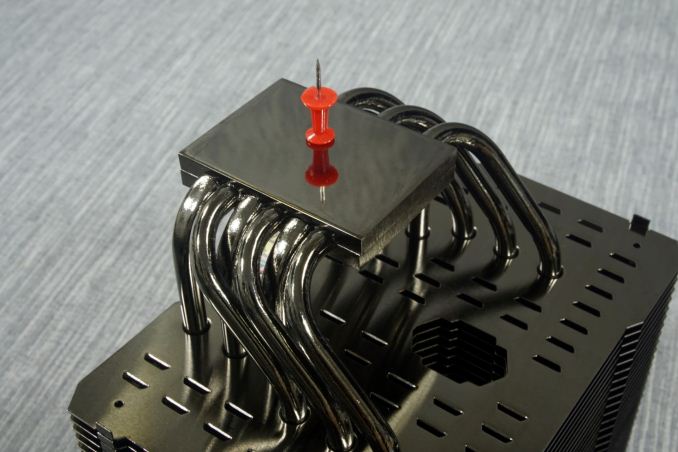








135 Comments
View All Comments
zodiacfml - Tuesday, July 7, 2015 - link
Someone should test for this. It is quite plausible as it will take time to increase the temperature of water/coolant in the system. Yet, for longer and continuous loads, surface area matters to dump heat in the environment which AIO coolers has less to a similarly priced Big Air cooler which shows in benchmarks.Navvie - Tuesday, July 7, 2015 - link
Pretty good.It'd be nice if there was a base line (say intel's current stock cooler) and an AIO water cooler to show the difference between a top tier air cooler and what many consider to be the next step.
One point, SPCR always test each cooler with a 'reference' fan, making it easier to compare the heatsink's efficiency. Can't help but feel you didn't complete the task you set out to by levelling the playing field with your simulated CPU heat source.
maximumGPU - Tuesday, July 7, 2015 - link
Great roundup! i for one still believe high end air a good alternative to water if you want dead silence.What i still can't understand is how can Nocuta get away with shipping the most expensive air cooler, likely to be used by enthusiasts who care about aesthetics, with the most hideous fan colours?
'nar - Tuesday, July 7, 2015 - link
Noctua colors are odd, but I think it forces you to consider performance more than aesthetics. They do look nice, but not "cool" - no pun in tended.Dead silence basically depends on how much heat you need to dissipate, temperature of ambient air, surface area of fins/radiator, air flow, and heat transfer capability of the cooler. Or more basically, how easily you can transfer heat from CPU to the air. Water increases the efficiency of heat transfer, so once you reach a certain power level they will overtake HSF's. They will never be as quite as a good HSF, at least not on low-power CPU's that arguably do not need anything but the stock cooler to begin with.
xthetenth - Tuesday, July 7, 2015 - link
Noctua gets away with those colors entirely because they're Noctua. Yes they're not pretty colors, but unlike nice bright/garish colors they are an unmistakable sign that they're the best or at least tied for best.piroroadkill - Wednesday, July 8, 2015 - link
Your keyboard seems to have a problem, you've typed "hideous" when clearly "fantastic" would be better. Noctua fans are neat.Beaver M. - Wednesday, July 15, 2015 - link
Well, serious people are more likely to buy Noctua anyway. And no serious user cares about what the fans look like, and even if they did, they would still take the Noctua, since you can CLEARLY see the extremely high quality they are just by looking at them. Windows in cases and other stupid bling bling is for the PC-ricer gang. They only choose after looks anyway, and dont care if their fans make noises from day one.PrinceGaz - Tuesday, July 7, 2015 - link
Excellent review of what seem to be very good HSFs throughout (but then again, you did ask them to send their best).A comparison with the stock Intel cooler as supplied with something like the 4790K would be nice, as that is what any expense on a third-party cooler must be compared against. How would the stock-cooler compare at 340W? I was very impressed with the degC/W figures for all those coolers; it almost makes 340W seem an amount of heat that can be dealt with, though I'm thinking it's crazy.
As well as the stock-cooler from a highish end CPU, one or two commonly used AIO liquid-coolers needs to be added to provided a second comparison point, as these high-end air-coolers are presumably expected to be near, possibly even better than a liquid AIO.
I love the fact you are using a properly designed heating rig, and your comprehensive review, but I came away thinking: they're good! But I've no idea how much better they are than the stock cooler, or how any of them would compare with the liquid AIOs also available, both in terms of cooling or noise.
Sivar - Tuesday, July 7, 2015 - link
This is probably the best CPU cooler article I've read (and I read such articles when Anandtech when it was on Geocities).Excellent writing, useful measurements, and a cogent conclusion. Thank you, Emmanouil!
orangesky - Tuesday, July 7, 2015 - link
SilentPcReview just posted a review of the new Scythe Ninja 4: http://www.silentpcreview.com/article1462-page1.ht... The review includes some good comparison tables with many of the popular air & water coolers.Sounds like a pretty decent option, and probably the best Ninja since the original.